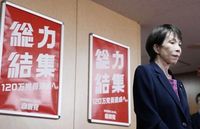Japan’s political landscape has been thrown into turmoil after the shock collapse of a 26-year ruling coalition, leaving the country’s next prime minister up for grabs and sparking a scramble among parties for new alliances. In a dramatic series of developments, Sanae Takaichi, the recently elected head of the Liberal Democratic Party (LDP) and a figure once seen as poised to become Japan’s first female prime minister, now faces a daunting uphill battle. Her prospects dimmed sharply after Komeito, the LDP’s junior partner, ended their long-standing partnership on October 10, 2025, citing deep policy rifts and mounting scandals.
Yuichiro Tamaki, leader of the Democratic Party for the People (DPP), seized on the moment, calling on opposition parties to unite around shared policies and potentially form a new government. “It will be essential for us to achieve consensus on basic policies,” Tamaki told reporters at a press conference, according to Kyodo News. Tamaki, whose party has grown into the second-largest opposition force in the House of Councillors, emphasized that only a united front could challenge the LDP’s dominance and offer voters a genuine alternative.
The urgency of Tamaki’s call was underscored by the extraordinary circumstances. The LDP, while still the largest force in both chambers of parliament, no longer commands a majority. In the powerful 465-seat lower house, the party holds 197 seats—far short of the 233 required for control. Their position in the upper chamber is similarly precarious, with 101 seats versus the 125 needed for a majority. Takaichi, a staunch conservative and nationalist, was expected to coast to the premiership after her October 4 victory in the LDP leadership race. But the unraveling of the coalition has left her isolated, her path to power suddenly uncertain.
Opposition parties wasted no time in responding to the new political reality. On October 14, 2025, senior members of the DPP, the Constitutional Democratic Party of Japan (CDPJ), and the Japan Innovation Party (JIP) agreed to arrange a meeting of their party leaders the following day. Their goal: to hash out policy differences and consider backing a single candidate for prime minister in the upcoming parliamentary vote, scheduled for October 21. The CDPJ, led by former prime minister Yoshihiko Noda, has floated the idea of supporting a unified candidate from outside its own ranks, with Tamaki emerging as a potential consensus choice.
But unity among the opposition is far from guaranteed. Major policy differences remain, particularly on national security and energy. Tamaki has urged the CDPJ to “shift to more realistic policies on national security,” specifically referencing the party’s opposition to collective self-defense and its stance against building new nuclear plants. The DPP, by contrast, supports nuclear energy—a position that sets it apart from the CDPJ, which has advocated for zero nuclear power since the Fukushima disaster in 2011. “If we were to join together in a coalition government, alignment on fundamental policies would be essential,” Tamaki stressed, according to statements reported by Asahi Shimbun. “If there’s no alignment, the administration will be volatile.”
The stakes are high. Should the opposition parties manage to bridge their differences and unite, they could muster enough votes to form a government and block Takaichi from taking power. The CDPJ’s Noda described the current situation as “a once-in-a-decade chance for a change of government.” JIP leader Hirofumi Yoshimura has also expressed his readiness to discuss a three-way collaboration, signaling a rare moment of openness among Japan’s often fractious opposition forces.
Meanwhile, the LDP is not standing still. Secretary General Shunichi Suzuki has reportedly reached out to the DPP, seeking cooperation in the parliamentary vote to select the next prime minister. But the party’s hand is weakened not only by its loss of Komeito but also by mounting public dissatisfaction and a string of damaging scandals. The most recent controversy centers on Takaichi’s appointment of Koichi Hagiuda, a disgraced ex-minister who resigned less than two years ago over a major financial scandal, to a senior LDP position. This move infuriated Komeito and further alienated voters already wary of the LDP’s ethics.
Another flashpoint is Takaichi’s ambiguous stance on the Yasukuni Shrine, a site honoring Japan’s war dead—including convicted war criminals—which remains a source of intense friction with China and the Koreas. Takaichi has refused to rule out future visits to the shrine, insisting it is “not a diplomatic issue” and that the proper way to honor the war dead “should be judged at the appropriate time.” Her hawkish positions on security and foreign policy, especially regarding South Korea and China, were cited by Komeito as key reasons for their split. “Komeito was already worried about Takaichi’s hawkish stance on security, on relations with South Korea and China, and their fear was that she would go even further as soon as she was in office,” said Hiromi Murakami, a political science professor at Temple University’s Tokyo campus, speaking to DW.
For Takaichi, the path forward is fraught with obstacles. She has vowed not to give up, telling an audience in Tokyo, “I’m absolutely determined to become Prime Minister,” as reported by NHK. Yet, without Komeito’s support and facing a possible united opposition, her chances look slimmer by the day. Even Komeito leader Tetsuo Saito has indicated that his party might back an opposition candidate in the parliamentary vote, saying he “will not rule out any possibility.”
The mechanics of the prime ministerial selection process add another layer of complexity. To secure the premiership, a candidate must win more than half the lawmakers’ votes in the first round. If no one achieves a majority, a runoff between the top two contenders follows, with the lower house’s choice taking precedence. With the LDP’s numbers diminished and opposition forces circling, the outcome is anything but certain.
Political analysts are blunt in their assessment of the LDP’s predicament. “Takaichi and the LDP are both in deep trouble,” said Toshimitsu Shigemura, professor of politics at Waseda University, to DW. He noted that the party’s decision to back Takaichi over the more moderate Shinjiro Koizumi—who might have kept Komeito in the fold—now looks like a costly miscalculation. The LDP, Shigemura added, “does not have a political philosophy. It is simply trying to survive. And that is very worrying because the nation faces many serious issues that need to be addressed, at home and abroad.”
With the parliamentary vote looming and political horse-trading in full swing, Japan finds itself at a rare crossroads. Should the opposition succeed in forming a government, it would mark the first time since 1996 that a non-LDP politician has held the prime minister’s office. For now, the nation waits—its political future hanging in the balance as rivals jostle for power and consensus proves elusive.



